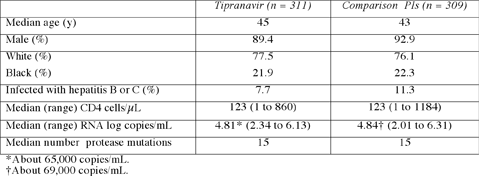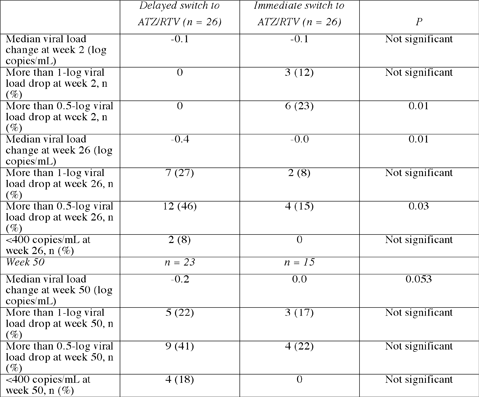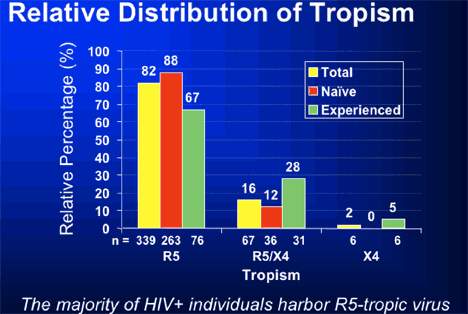 |
 |
 |
| |
ICAC ART Report: New HIV Drugs- tipranavir/r; Reverset; GSK CCR5 Inhibitor 140
|
| |
| |
News on New(er) Antiretroviral
Report 4 from the 14th ICAAC, October 30-November 2, 2004, Washington, DC
Written for NATAP by Mark Mascolini
The biggest new-drug news from the ICAAC meeting involved tipranavir, the protease inhibitor (PI) that seems sure to set the gestation record for modern antiretrovirals. Partly because tipranavir's ownership changed hands halfway through its development, this promising PI has spent more time in the pipeline than some drugs spend on the formulary.
Tipranavir/ritonavir for PI-resistant virus
The wait has been particularly agonizing for people with virus rich in protease resistance mutations, because early work established that HIV resistant to other PIs often remains susceptible to tipranavir (1). But the story may have a happy ending, results from the 600-person RESIST-1 trial suggest, though some questions remain unanswered (2). RESIST-1 recruited people in North America and Australia who had tried two or more PIs and were taking a PI regimen with a viral load above 1000 copies/mL. (RESIST-2 signed up the same type of people in South America and Europe and will debut at the Glasgow HIV meeting.) Everyone had to have one or more of seven pivotal PI mutations but (and here's the but) people could have no more than two mutations at four keystone cross-resistance sites: protease positions 30, 82, 84, and 90. Still, study participants had lengthy PI records and lots of resistant virus. The median number of protease mutations stood at 15, so these enrollees represented many of the hard-to-treat people sitting in HIV clinics today. RESIST-1 researchers randomized them to take tipranavir/ritonavir at a dose of 500/200 mg twice daily or to take another ritonavir-boosted PI picked by their study clinician—lopinavir/ritonavir, saquinavir/ritonavir, indinavir/ritonavir, or amprenavir/ritonavir. People in the two study groups matched closely in disease progression, CD4 count, and viral load:
|
|
| |
| |
 |
|
| |
| |
A panel of experts surveying enrollees' genotypes recommended boosted PIs for individuals randomized to the control arm. Only about 30% of trial physicians followed this advice. The most-favored PI in the comparison arm—lopinavir/ritonavir—turned out to be the one least likely to rein in replication of virus circulating in this study population. Phenotyping (which figures the relative susceptibility of a mutant virus versus nonmutant virus to a particular drug) rated lopinavir/ritonavir as the worst choice for this study group:
Percent use in control arm Median fold-change in susceptibility vs nonmutant virus
|
|
| |
| |
 |
|
| |
| |
Besides their PIs, study participants took other antiretrovirals that seemed likely to lower their viral load, and for some that meant the fusion inhibitor enfuvirtide (T-20). Researchers defined failure as less than a 0.5-fold (3 times) drop in viral load, a viral load above 100,000 copies/mL, or rebound to less than a 1-log (10 times) decrease from the starting viral load. After 24 weeks of treatment, people randomized to tipranavir/ritonavir had significantly better viral load readings than those randomized to a different boosted PI:
|
|
| |
| |
 |
|
| |
| |
Adding T-20 to tipranavir/ritonavir helped more than adding T-20 to a control-arm PI. In the tipranavir group, 47% who also took T-20 reached a viral load below 400 copies/mL, compared with 22% taking T-20 with another boosted PI. About one third of those combining T-20 and tipranavir had a 24-week viral load under 50 copies/mL, compared with 14% combining T-20 and a different PI. Duke University's Charles Hicks, who presented the RESIST-1 results, did not have data comparing the tipranavir groups who did or did not take T-20. After 24 weeks researchers counted 13 virologic failures (4%) in the tipranavir group and 109 (35%) in the control group. Did the frequent use of lopinavir skew results in favor of tipranavir? Hicks argued no. Although viral susceptibility to lopinavir was low (two tables above), susceptibility to indinavir, saquinavir, and amprenavir was pretty poor too. Still, it will be interesting to see a PI-by-PI comparison of the virologic results. How about side effects? Here tipranavir didn't do as well as the other PIs. Among 48 tipranavir takers who stopped the drug before 24 weeks of follow-up, 25 did so because of side effects. Nine of the 139 people who stopped another PI did so because of side effects. Significantly more people taking tipranavir than taking a comparison PI had grade 3 or 4 jumps in alanine aminotransferase (ALT, 6.9% versus 1.3%, P < 0.001), total cholesterol (4.2% versus 0, P < 0.001), and triglycerides (21.7% versus 12.5%, P < 0.01). Considerably more tipranavir takers also had grade 3 or 4 leaps in aspartate aminotransferase (AST, 21.7% versus 12.5%, P < 0.06). Few people with high ALTs, ASTs, or lipids had to stop tipranavir as a result.
Where will tipranavir fit in?
How will tipranavir/ritonavir do in people with more resistance than those in this study? Early results of a trial reported earlier this year suggest that this boosted PI won't rescue many of them (3). Even adding a third PI to tipranavir/ritonavir didn't do much in this study, perhaps because of a nettlesome interaction between tipranavir and other PIs. Drugs from all three main antiretroviral classes had failed in this study's 296 participants. They had a median viral load close to 100,000 copies/mL and had three or more mutations at protease positions 33, 82, 84, or 90. Researchers randomized them to take tipranavir/ritonavir (500/200 mg twice daily), saquinavir/ritonavir (1000/100 mg twice daily), amprenavir/ritonavir (600/100 mg twice daily), or lopinavir/ritonavir (400/100 mg twice daily). After 2 weeks, people taking ritonavir-boosted saquinavir, amprenavir, or lopinavir could add tipranavir plus another 100 mg of ritonavir. Two-week viral load drops were greater with tipranavir (1.2 logs) than with the other PIs (0.2 to 0.4 log). When people added tipranavir and an extra ritonavir boost to the other PIs, viral loads dipped sharply. But after 8 weeks of treatment, median viral loads had rebounded in every group, including people who stayed with only tipranavir/ritonavir. Adding tipranavir sliced lopinavir's trough concentration by about 45%, amprenavir's by about 50%, and saquinavir's by about 80%. These interactions apparently undermined triple-PI therapy for these people. Both this study and the two RESIST trials continue.
Little salvage luck with atazanavir/ritonavir/tenofovir
The RESIST trial (above) didn't include atazanavir/ritonavir as a comparison option, but results of a French trial indicate that this once-daily PI plus tenofovir disoproxil fumarate (TDF) does little to help people with thick resistance histories (4).
Christophe Piketty (Hôpital Georges Pompidou, Paris) and French national AIDS trials group (ANRS) colleagues signed up 53 people in whom at least two PI regimens and one nonnucleoside regimen had failed. Everyone had a viral load above 10,000 copies/mL, and no one had tried atazanavir or TDF. Anyone taking a nonnuke had to stop that drug. Then the ANRS team randomized 27 people to continue their current PI and nucleosides and 26 to swap their PI for 300/100 mg of atazanavir/ritonavir once daily. Two weeks later everyone switched to atazanavir/ritonavir plus TDF and other nukes picked to match resistance profiles.
The median starting viral load stood at about 100,000 copies/mL in both groups, with a median CD4 count of 175 cells/µL in the immediate-switch group and 267 cells/µL in the delayed-switch group. The median number of primary and secondary PI mutations numbered 9 in the immediate group and 8 in the delayed group. Respective numbers of AZT or d4T mutations were 4 and 3. Three quarters of enrollees had tried lopinavir/ritonavir and half had tried amprenavir. The report didn't list only primary PI mutations.
By itself (after week 2) atazanavir/ritonavir did almost nothing to control HIV. Adding TDF and hand-picked nucleosides later didn't help much either:
|
|
| |
| |
 |
|
| |
| |
Median CD4 counts had edged downward during the study. Four people had to drop out of the trial because of side effects, 2 for problems related to TDF (Fanconi syndrome and renal tubular disorder). Median total cholesterol and triglycerides fell significantly during the study. An earlier Bristol-Myers Squibb study comparing boosted atazanavir plus TDF with lopinavir/ritonavir plus TDF in people with PI failure rated atazanavir "noninferior" to lopinavir (5). As Piketty and colleagues observed, people in that study had less PI experience than those in the ANRS trial. Some work indicates that TDF lowers concentrations of atazanavir, even when boosted by ritonavir (6), but other work failed to confirm this finding (7).
Can Reverset reverse nuke resistance?
D-D4FC, a once-daily nucleoside analog already named Reverset, pared viral loads by 1.77 logs in a 10-day 200-mg monotherapy study of treatment-naive people (8). The drug also did well when added to failing regimens in a double-blind placebo-controlled trial involving 10 people (9). The add-on study, reported at ICAAC by Robert Murphy (Northwestern University, Chicago), randomized 8 people to add 200 mg of Reverset once daily and 2 to add placebo to a failing regimen. Among the 8 people assigned to take Reverset, 5 had the M184V mutation and 4 had three or more thymidine analog mutations. Nobody had the K65R mutation evoked by both TDF and Reverset, and 2 people had no nucleoside mutations. In response to a question from the audience, Murphy said that after 15-30 passages in the in vitro resistance study of Reverset the K65R emerged. Ten days of Reverset intensification trimmed viral loads by an average 0.8 log. Seven of 8 people taking the drug had more than a half-log drop in viral load, and 4 reached a load below 400 copies/mL. The 4 people with three or more thymidine analog mutations did somewhat worse than other study participants. The only person in whom Reverset did nothing had thymidine analog mutations at positions 41, 67, 210, and 215. A phase 2b trial of Reverset aiming to enroll 180 people is under way.
Another CCR5 antagonist (and clues on when to use it)
GlaxoSmithKline hasn't picked a name for his CCR5 receptor antagonist, which goes by the number 873140—or 140 for short. Glaxo's Stephen Piscitelli offered results of a 10-day monotherapy study involving 21 people with treatment experience and 19 still naive to antiretrovirals (10).
To get into the study, people had to have a stable viral load at or above 5000 copies/mL for 30 to 90 days, a CD4 nadir above 200 cells/µL, and virus that homed to the CCR5 HIV coreceptor. People with treatment experience had to stop therapy for 12 weeks before starting 140. Piscitelli and colleagues randomized 8 people to placebo and 32 people to one of four doses of the CCR5 drug:
• 200 mg once daily
• 200 mg twice daily
• 400 mg once daily
• 600 mg twice daily
After 10 days of treatment, viral loads dropped most with the highest dose:
|
|
| |
| |
 |
|
| |
| |
No one had serious side effects. Some people had gut problems (pain, diarrhea, nausea, flatulence) that usually went away in a few days. The drug plugged up more than 95% of CCR5 receptors, even after treatment stopped. Higher doses tended to stick to receptors longer after people stopped taking 140. With several CCR5 and CXCR4 antagonists gurgling through the development pipeline, clinicians will eventually have to decide which people may benefit from which type of drug. To help make that decision, researchers have started cataloging these coreceptors in people at different stages of HIV disease and even trying to predict which coreceptor—if either—is likely to predominant.
HIV that uses the CCR5 doorway (called R5-tropic virus) is the type typically transmitted to a newly infected person. As HIV disease gets worse, the virus may change to the CXCR4 receptor (and become X4-tropic). But that doesn't always happen. Plenty of people get to the final stages of AIDS with only R5 virus. Rating virus in 325 treatment-naive people and 117 with treatment experience, Glaxo's Jim Demarest found that R5-tropic virus predominated in both groups (11). R5-tropic HIV turned up in 88% of treatment-naive people, 67% of treatment-experienced people, and 82% overall. He found mixed R5/X4 virus in 12% of the naive, 28% of the experienced, and 16% overall. Purely X4-tropic virus cropped up in none of the naive, 5% of the experienced, and 2% overall.
|
|
| |
| |
 |
|
| |
| |
A multivariate analysis involving treatment-experienced people picked out three factors that raised the odds of having X4 virus:
• PI experience: odds ratio (OR) 4.167, P = 0.0085
• Each additional year of age: OR 1.055, P = 0.039
• Non-Caucasian race: OR 5.13, P = 0.0015.
Comments by Jules Levin: A couple of points. We don't know the clinical significance of having X4 or R5 virus, and we don't know if having X4 is cause or effect. In other words, we don't know if having X4 predicts advancing disease or if having X4 is simply a reflection of having advanced disease. So, detecting X4 does not necessarily mean that a patient will advance in disease status, but it could meanb they developed X4 as a result have advancing HIV. I hope & expect that clinical studies by GSK, BMS, and Pfizer will answer these important questions. Finally, multivariate analysis among treatment-naives in the GSK study found CD4/CD8 ratio associated with X4 tropism: 0.1 decrease in ratio increases odds ratio of detectable X4 tropism by 1.76 (OR), p<0.0001).
The PI and racial variables may be misleading, Demarest warned. PI experience could simply be a marker of more overall antiretroviral experience, and the racial finding may reflect poorer health care among nonwhites, and thus a higher risk of advanced HIV disease, when X4 virus emerges.
At London's Chelsea and Westminster Hospital, Graeme Moyle traced coreceptor tropism in 563 people, 161 with and 402 without treatment experience (12). Compared with people carrying R5 virus, those with mixed R5/X4 virus or just X4 tended to have a higher viral load (66,228 versus 35,800 copies/mL, P < 0.001), lower CD4 count (231 versus 307 cells/µL, P = 0.007), and lower CD4% (15.4% versus 18.7%, P = 0.001). Moyle's multivariate model confirmed the highest risk of X4 tropism in people in:
• The highest viral load quartiles
• The lowest CD4 quintiles
• The lowest natural killer (NK) cell quintiles
But, reflecting Demarest's results, Moyle's study showed that R5- and X4-tropic virus can be found among people in all CD4 and viral load strata. So when coreceptor antagonists do find their way to pharmacy shelves, clinicians may have to test for tropism before prescribing these drugs.
Mark Mascolini writes about HIV infection (mailmark@ptd.net).
References
1. Larder BA, Hertogs K, Bloor S, et al. Tipranavir inhibits broadly protease inhibitor-resistant HIV-1 clinical samples. AIDS 2000;14:1943-1948.
2. Hicks C. RESIST-1: a phase 3, randomized, controlled, open-label, multicenter trial comparing tipranavir/ritonavir to an optimized comparator protease inhibitor/r regimen in antiretroviral experienced patients: 24-week data. 44th Interscience Conference on Antimicrobial Agents and Chemotherapy (ICAAC). October 30-November 2, 2004. Washington, DC. Abstract H-1137a.
3. Leith J, Walmsley S, Katlama C, et al. Pharmacokinetics and safety of tipranavir/ritonavir alone or in combination with saquinavir, amprenavir, or lopinavir: interim analysis of BI1182.51. 5th International Workshop on Clinical Pharmacology of HIV Therapy. April 1-3, 2004. Rome. Abstract 35.
4. Piketty C, Gerard L, Chazallon C, et al. Efficacy and safety of atazanavir/ritonavir when combined to tenofovir in HIV-infected patients with multiple treatment failures: Puzzle 2—ANRS 107 trial. 44th Interscience Conference on Antimicrobial Agents and Chemotherapy (ICAAC). October 30-November 2, 2004. Washington, DC. Abstract H-571.
5. Badaro R, DeJesus E, Lazzarin A, et al. Efficacy and safety of atazanavir with ritonavir or saquinavir versus lopinavir/ritonavir in combination with tenofovir and one NRTI in patients who have experienced virologic failure to multiple HAART regimens: 16-week results from BMS AI424-045. 2nd IAS Conference on HIV Pathogenesis and Treatment. July 13-16, 2003, Paris. Abstract 118.
6. Taburet AM, Piketty C, Gerard L, et al. Pharmacokinetic parameters of atazanavir/ritonavir when combined to tenofovir in HIV infected patients with multiple treatment failures: a substudy of Puzzle 2-ANRS 107 trial. 10th Conference on Retroviruses and Opportunistic Infections. 10-14 February 2003. Boston. Abstract 537.
7. Kruse G, Stocker H, Breske A, et al. Trough levels of six different atazanavir regimens in HIV-infected patients. 5th International Workshop on Clinical Pharmacology of HIV Therapy. April 1-3, 2004. Rome. Abstract 49.
8. Murphy RL, Schürmann D, Beard A, et al. Tolerance and potent HIV-1 activity of Reverset following 10 days of mono-therapy in treatment-naive individuals. 11th Conference on Retroviruses and Opportunistic Infections. February 8-11, 2004. Abstract 137.
9. Murphy RL, Schürmann D, Levy R, et al. Tolerance and anti-HIV-1 activity of Reverset following 10 days as add-on therapy to current regimens in treatment experienced HIV-infected individuals. 44th Interscience Conference on Antimicrobial Agents and Chemotherapy (ICAAC). October 30-November 2, 2004. Washington, DC. Abstract H-1130.
10. Lalezari J, Thompson M, Kumar P, et al. 873140, a novel CCR5 antagonist: antiviral activity and safety during short-term monotherapy in HIV-infected individuals. 44th Interscience Conference on Antimicrobial Agents and Chemotherapy (ICAAC). October 30-November 2, 2004. Washington, DC. Abstract H-1137b
11. Demarest J, Bonny T, Vavro C, et al. HIV-1 co-receptor tropism in treatment naive and experienced subjects. 44th Interscience Conference on Antimicrobial Agents and Chemotherapy (ICAAC). October 30-November 2, 2004. Washington, DC. Abstract H-1136.
12. Moyle G, Wildfire A, Mandalia S, et al. Prevalence and predictive factors for CCR5 and CXCR4 co-receptor usage in a large cohort of HIV positive individuals. 44th Interscience Conference on Antimicrobial Agents and Chemotherapy (ICAAC). October 30-November 2, 2004. Washington, DC. Abstract H-1135.
|
| |
|
 |
 |
|
|